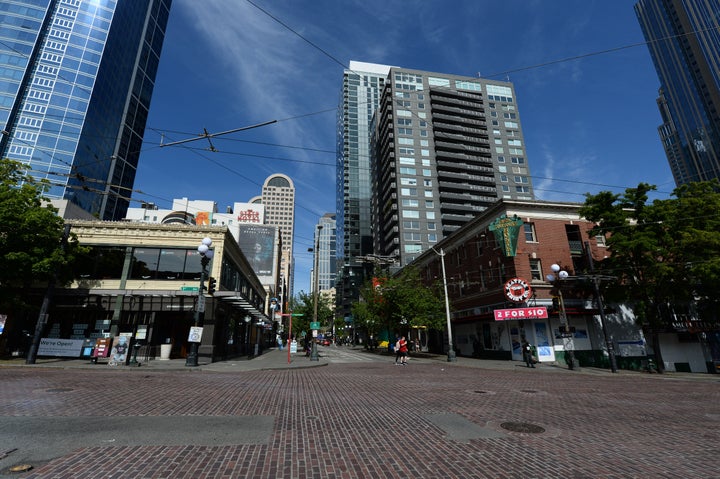
SEATTLE ― Gordon Padelford, the founder and director of Seattle Neighborhood Greenways, can barely finish a thought without pointing out a toddler on a balance bike or a couple walking their dog in the middle of the road.
“I’ve never seen that before!” he exclaims as we take a walking tour of one of Seattle’s new “Stay Healthy Streets,” which the city has closed to most vehicle traffic so people can be outside while maintaining a safe social distance. One of the streets just happens to run right by his house.
“Three hours after it went in,” Padelford said, “two kids and a dad biked by, and I had never seen kids that young biking in the street. As soon as people were invited to use the street, they did.”
All over the country, cities are closing down streets to car traffic and opening them up to people. It started with Oakland, where Mayor Libby Schaaf announced the city would close 74 miles to through traffic on April 10, and has spread across the country— to Portland, Oregon, Boston, San Francisco, Baltimore, Minneapolis, New York and beyond.
While the details vary slightly, the basic idea is the same: Block off a street to everything other than local traffic with removable barriers, and hope that people walking, biking or rolling will show up.
In Seattle, where more than one-quarter of city streets lack sidewalks, roadways can double as battlegrounds. Mayor Jenny Durkan got off on the wrong foot with bike and pedestrian activists when she dramatically scaled back the city’s ambitious bike plan in 2019, leaving Seattle’s traditionally underserved south end without any direct bike connections to downtown. Durkan initially seemed tentative about the idea of street closures, starting off by temporarily closing just 2.5 miles of streets in April and adding a few miles over the next few weeks.
But by early May, Durkan announced that the city would restrict 20 miles permanently, winning praise from groups like the Cascade Bicycle Club.
“As soon as people were invited to use the street, they did.”
- Gordon Padelford, founder and director of Seattle Neighborhood Greenways
Car traffic on major streets in Seattle declined 60% after Washington state Gov. Jay Inslee (D) issued his stay-at-home order in mid-March. But the gradual end of pandemic restrictions, combined with new anti-crowding measures on buses and trains, could bring that number skyrocketing back. King County’s public transit agency, for example, recently limited its bus capacity to a maximum of 12 to 18 riders.
At the same time, the city is facing massive budget cuts exacerbated by the April discovery that the West Seattle Bridge connecting West Seattle to the rest of the city had suffered major damage and would be shut down. A replacement will likely cost hundreds of millions of dollars. Finding other ways to get people around cheaply could soften the blow.
“Making aggressive investments in active transportation and walking and biking— that is going to be part of the city’s overall recovery strategy,” Seattle Department of Transportation Director Sam Zimbabwe said in an interview. “The type of investments we need to make are going to look different as people start to travel more. We need to look at every possible way to keep the city moving, and that doesn’t mean that everyone is going to jump in a car.”
Addressing Equal Access
In Oakland, where the city has been slowly closing more streets to cars, one issue quickly became paramount: equity. Which parts of the city were getting the new “slow streets,” and was the city reneging on its promises of permanent pedestrian and bike safety infrastructure by throwing up a few signs and traffic cones?
In areas where the city has traditionally underinvested, people wondered why the city didn’t do something more permanent, said Chris Hwang, the board president of Walk Oakland Bike Oakland, a group that advocated for closing streets.
Ryan Russo, Oakland’s director of transportation, said the city has been criticized, “and rightfully so,” for initially using an online portal for feedback and suggestions about the plan, making it inaccessible to anyone without a computer or smartphone.
Most of the early feedback was coming from white, wealthy residents of North Oakland, so the city pivoted “to make sure we’re creating structures of meaningful engagement for communities that have been poorly served by their government” in the past, Russo said. “We don’t want Slow Streets to seem like something that is being done to a community.”
“We need to look at every possible way to keep the city moving and that doesn’t mean that everyone is going to jump in a car.”
- Seattle Department of Transportation Director Sam Zimbabwe
Hwang said the Safe Streets plan was part of a much broader proposal her organization put forward that included blocking off parking lanes near parks where people tend to congregate, having walk signals at street crossings cycle on automatically instead of requiring pedestrians to push a button to activate them, and installing temporary signage to tell drivers to slow down because more people are using the streets.
Schaaf’s April announcement that the city was adopting part of that plan “was a pleasant surprise to us,” Hwang said.
Hwang said Oakland has done a good job of adapting the plan to needs it didn’t originally anticipate, like the fact that some streets must be open for emergency vehicles.
But in traditionally neglected areas of the city like deep East Oakland, where residents have been fighting for permanent safe bike lanes and traffic calming measures, “the perception was that the city was throwing up some cheap stuff and calling it infrastructure,” Hwang said. “Now that the pilot has happened, people are demanding something much better for calming traffic. So we might be using this as a way to accelerate projects that were in the pipeline but not high up on the priority list.”

Zimbabwe, the Seattle DOT director, said Seattle is also taking equity into account as it decides which streets to close. “These aren’t just anywhere. It’s not write in and have your block closed,” he said. “These are providing connections across the city.”
Some advocates, however, have criticized the city’s approach because the streets aren’t typically the ones commuters use and aren’t located in denser neighborhoods, where it can be especially hard to maintain a safe social distance. The route map is based on an existing network of neighborhood greenways — narrow streets in mostly single-family areas where speed cushions and lane markings signal to drivers that they should slow down or move over to an arterial street.
“It’s great that [the program is] acting as a boost for neighborhood greenways, but we don’t have those in every neighborhood,” Seattle Neighborhood Greenways community organizer Clara Cantor said.
Overcoming Car Culture
Programs like parking removal and slow streets may be popular when people are driving less, but could become more controversial as cities open back up. Already, one anti-bike lane group in Seattle called “Neighborhoods for Smart Streets” is advocating against closing streets in Northeast Seattle, the only part of the city not included in the program so far.
By and large, however, advocates say most neighborhoods have welcomed the closures. “I thought it was going to be a lot more controversial than it has been,” Cantor said. “I think there was just a hunger for this.”
Advocates say city leaders should start looking beyond greenways — which, they note, were already supposed to be restricted to local traffic — and start opening up streets in areas like downtown Seattle.
“I think that it’s important to look at which neighborhoods are being served by these Stay Healthy Streets and which aren’t,” said Vicky Clarke, the policy director for the Cascade Bicycle Club. “A second phase needs to look at where there are gaps.”
“I thought it was going to be a lot more controversial than it has been. I think there was just a hunger for this.”
- Seattle Neighborhood Greenways community organizer Clara Cantor
Seattle Neighborhood Greenways has proposed closing a total of 130 miles of streets throughout the city permanently, including many streets that are more heavily traveled — and would therefore be much more politically challenging to close.
Ordinarily, decisions to slow down street traffic or eliminate on-street parking are subject to a seemingly endless series of meetings, evaluations and legal challenges. But Clarke said the city’s response to bike and pedestrian needs during the pandemic has shown that it’s capable of acting fast.
“It’s really political will that has stood in the way of new things,” Clarke said. “Leadership is recognizing that things have changed and are making a change, instead of processing things to death.”
An early concern for both Oakland and Seattle was that closing off streets to car traffic would actually attract too many people. “One of the things that I think has sort of paralyzed cities is that we’re used to closing streets for block parties or parades or big community events, and with COVID-19, no one wanted to create an attractive nuisance,” said Oakland’s Russo.
Seattle shared this concern. But advocates say that reopening businesses may actually require opening streets up for uses like cafe tables and outdoor seating.
“There’s nothing about streets that necessarily means they have to be only for driving,” Padelford said. “It’s largely a cultural construct who these streets are for and how they’re supposed to be used, and who is welcome and unwelcome.”
A HuffPost Guide To Coronavirus
- Stay up to date with our live blog as we cover the COVID-19 pandemic
- 7 essential pieces of relationship advice for couples in quarantine
- What you need to know about face masks right now
- How to tell if you need to start doing online therapy
- Lost your job due to coronavirus? Here’s what you need to know.
- Parenting during the coronavirus crisis?
- The HuffPost guide to working from home
- What coronavirus questions are on your mind right now? We want to help you find answers.
- Everyone deserves accurate information about COVID-19. Support journalism without a paywall — and keep it free for everyone — by becoming a HuffPost member today.
